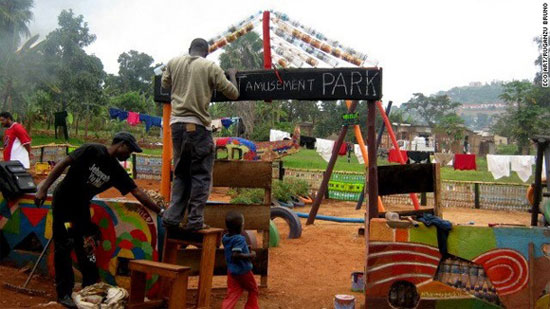'Waste park' - art for the community
After collecting a large amount of waste, about 20,000 plastic bottles in the slums of Kampala (Uganda), Ruganzu Bruno's group embarked on assembling 'artworks'. The park is made up of garbage itself, which has become a favorite play area for children in the area.
From the desire to change the environment
As soon as Ruganzu Bruno and his group arrived at Kampala's Kawempe area, the locals huddled with curiosity: 'What are you doing? Why take these discarded plastic items? ' - they asked in a rush when Bruno's group picked up a pile of waste plastic bottles filled with warehouses on the northwestern outskirts of Uganda Capital. And then, from curiosity, the people showed interest and interest in the project with the works made from recycled materials. "We want to send people the message that when they throw away the garbage, they can also pick it up and reuse it and protect the environment," Bruno said. At first, people were embarrassed, but after that, they really liked this job. They often give us a lot of 'garbage'.
It was about 4 years ago, when Bruno was still a Kyambogo Fine Arts University student. At that time, the talented painter discovered that he was not only interested in artworks that met his own creative needs but wanted his artistic creation to have a positive impact on the community. .'Artists like us tend to work for themselves. But I feel a change in myself, since then, I have not only painted but decided to create works that are beneficial to the community ' - artist Bruno, 30, from southwest Uganda explained.

Prompted by his desire to change the environment, Bruno was involved in the artistic ecology project, offering innovations to deal with the problem of waste treatment in Kampala. In 2010, he founded Eco Art Uganda, a group of artists with the same idea, taking advantage of all discarded waste such as televisions and computers to raise awareness about environmental protection.'I look for cheap, readily available materials and find that garbage can really become a tool to convey my ideas,' Bruno said. He is now a lecturer in Kyambogo University's School of Art Design.
100 renewable parks
In April 2012, Bruno won a $ 10,000 prize at the Doha TED Conference, Qatar for the idea of creating an entertainment playground for children living in the crowded slums of Kampala. Using a variety of recycled materials, Bruno has turned a schoolyard in the Kireka, Kampala area into a fun, safe place for children to play and learn.
The ecological park was completed in September 2012 with exotic models, attracting dozens of children to come every day - from colorful helicopters to realistic, big game models made of plastic bottles. recycling or customized climbing frames from old tires.
Bruno said that local people enthusiastically responded to this project because children here were too short of entertainment areas.'I talked to the principal and parents and students who helped us collect bottles. So we created a playground together and they knew how to fix it when they were damaged. This is very important to maintain a sustainable playground. But more importantly, this project has had a positive impact on the children, ' Bruno said. Children are more interested in going to school than before, the number of children dropping out of school has decreased because there is now something to 'keep' them at school, fun activities also help them make much progress in learning.
Bruno said his goal was to recreate about 100 similar theme parks in Uganda elsewhere. It is part of Bruno's relentless effort to have works for his community.'I think that people are always remembered by the work he did. I am a supporter of the environment, support children to play, and I am an artist . I want my works to be effective for the community , "Bruno said.
- Garbage is also a resource to take advantage of
- Australia helps manage Ba Be National Park waste
- How long does it take for plastic waste to decompose?
- Sweden recycles 99% of its waste
- Utilizing food waste - a new mission of biotechnology
- New solution for waste in Vietnam
- Small questions: What is the amount of
- Vietnam is the top 5 countries that discharge most plastic waste into the sea
- Controversy about Dong Nai 6 and 6A hydropower
- Czech Republic tightens the mandatory classification of waste
- Electric waste like global time bomb
- There is an entirely new form of pollution in plastic and it is causing a headache for the scientific community
 Norway built the world's tallest wooden tower
Norway built the world's tallest wooden tower Kremlin
Kremlin Ashurbanipal: The oldest royal library in the world
Ashurbanipal: The oldest royal library in the world Decoding the thousand-year construction of Qin Shihuang shocked the world
Decoding the thousand-year construction of Qin Shihuang shocked the world